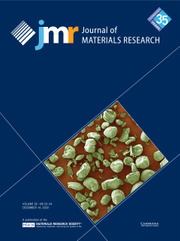Crossref Citations
This article has been cited by the following publications. This list is generated based on data provided by
Crossref.
Lu, Dong
Yang, Yi
Qin, Yi
and
Yang, Gang
2013.
Forming Microgears by Micro-FAST Technology.
Journal of Microelectromechanical Systems,
Vol. 22,
Issue. 3,
p.
708.
Yang, Xian Zhi
Yang, Yi
Yang, Gang
Qin, Yi
and
Yin, De Qiang
2014.
The Effect of Particle Deformation on Densification of 316L Stainless Steel under Micro-FAST.
Advanced Materials Research,
Vol. 939,
Issue. ,
p.
152.
Yang, Yi
Huang, Kunlan
Yang, Gang
Yin, Deqiang
Zhou, Yu
and
Qin, Yi
2015.
Micromanufacturing Engineering and Technology.
p.
257.
Yavas, Baris
Sahin, Filiz
Yucel, Onuralp
and
Goller, Gultekin
2015.
Effect of particle size, heating rate and CNT addition on densification, microstructure and mechanical properties of B4C ceramics.
Ceramics International,
Vol. 41,
Issue. 7,
p.
8936.
Wu, Mingxia
Yang, Gang
Yang, Yi
Qin, Yi
Yin, Deqiang
Qin, Y.
Dean, T. A.
Lin, J.
Yuan, S. J.
and
Vollertsen, F.
2015.
Microstructure evolution and surface cleaning of Cu nanoparticles during micro-forming fields activated sintering technology.
MATEC Web of Conferences,
Vol. 21,
Issue. ,
p.
10002.
Long, Zhang
and
Heng-wei, Zheng
2018.
Sintering driving force of Al2O3 powders at the initial stage of pulse electric current sintering under thermoelastic diffusion.
International Journal of Mechanical and Materials Engineering,
Vol. 13,
Issue. 1,
Pourebrahim, Alireza
Baharvandi, Hamidreza
Foratirad, Hamze
and
Ehsani, Naser
2018.
Effect of aluminum addition on the densification behavior and mechanical properties of synthesized high-purity nano-laminated Ti3SiC2 through spark plasma sintering.
Journal of Alloys and Compounds,
Vol. 730,
Issue. ,
p.
408.
Guillen-Romero, Luis Daniel
Oropeza-Guzmán, Mercedes Teresita
López-Maldonado, Eduardo Alberto
Iglesias, Ana Leticia
Paz-González, Juan Antonio
Ng, Theodore
Serena-Gómez, Eduardo
and
Villarreal-Gómez, Luis Jesús
2019.
Synthetic hydroxyapatite and its use in bioactive coatings.
Journal of Applied Biomaterials & Functional Materials,
Vol. 17,
Issue. 1,
Pourebrahim, Alireza
Baharvandi, Hamidreza
Foratirad, Hamze
and
Ehsani, Naser
2019.
Low temperature synthesis of high-purity Ti3SiC2 via additional Si through spark plasma sintering.
Journal of Alloys and Compounds,
Vol. 789,
Issue. ,
p.
313.
Huang, Kunlan
Chen, Wei
Wu, Mingxia
Wang, Jie
Jiang, Kyle
and
Liu, Jian
2020.
Microstructure and densification of the Ti6Al4V–70%TiB2 metal-ceramic by coupled multi-physical fields-activated sintering.
Journal of Alloys and Compounds,
Vol. 820,
Issue. ,
p.
153091.
Ogunbiyi, Olugbenga
Jamiru, Tamba
Sadiku, Rotimi
Adesina, Oluwagbenga
Adesina, Olanrewaju Seun
and
Olorundaisi, Emmanuel
2021.
Influence of Nickel Powder Particle Size on the Microstructure and Densification of Spark Plasma Sintered Nickel-Based Superalloy.
International Journal of Engineering Research in Africa,
Vol. 53,
Issue. ,
p.
1.
Lin, Huaixin
Jin, Gang
Zhan, Qiyun
Wang, Guangyu
and
Han, Jin
2024.
Mechanical Properties and Constitutive Model of TC4 Titanium Alloy at Cryogenic.
Journal of Materials Engineering and Performance,
Vol. 33,
Issue. 24,
p.
13731.
Zuo, Shangyong
Luo, Ting
Peng, Qian
Zhang, Tong
Xiong, Hengrong
Chen, Yihong
Wang, Yuehong
and
Peng, Zhiwei
2025.
Toward Novel Porous Boronized Ti6Al4V/FHA Composite Implants by Combined Microwave Sintering and Temporary Space Alloying.
Small Structures,
Vol. 6,
Issue. 5,
Zhang, Yanbin
Wei, Jian
Li, Xueting
Miao, Zhuang
Hou, Jiayi
Wang, Peng
Lv, Enhao
Yao, Yi
and
Zhang, Kai
2025.
Sintering, toughening mechanism and amorphization of B4C-based ceramic composites: A review.
Journal of the European Ceramic Society,
Vol. 45,
Issue. 4,
p.
117075.


